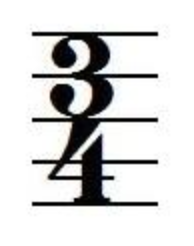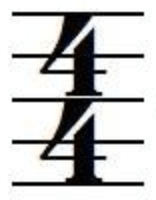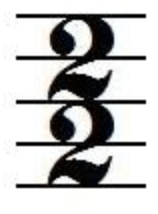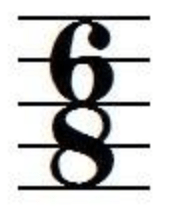How to Read Music in 6 8 Time
Office of our music theory series: Larn what time signatures mean in music.
What Are Time Signatures
I of the first things y'all will see when looking at a piece of music is the time signature. A time signature tells yous 2 important things:
- How many beats are in a mensurate
- What notation value gets the beat out Fourth dimension signatures will look like two numbers on top of each other, similar to a fraction.

Reading Time Signatures
The peak number tells y'all how many beats are in the measure. The bottom number tells y'all what note value will go the beat. You lot might exist wondering, how do I know what notation value is a 4? Attempt answering this: It would take 4 _ to equal a whole note. If you said, "quarter notes" you are right! So, seeing a 4 means the quarter note will become the beat.
Yous can ever determine which note will get the crush past figuring out the annotation value would take that many of to equal a whole note.
Looking at the example higher up, we know that the quarter note will get the beat (4) and there will be three (iii) beats per measure out. Here is an example of music in 3/four time. Y'all can meet the count of the beats under the measures.

Y'all know how to figure out which note value gets the shell, only to make things easier, here is a fourth dimension signature cheat canvass. If the bottom number is a: 1 - The whole annotation gets the beat out ii - One-half notes become the trounce iv - Quarter notes get the beat eight - Eighth notes go the beat sixteen - Sixteenth notes get the beat See if you can say which note receives the beat and how many beats are in a measure out for these examples:

this is the four-four time signature, at that place are four beats per measure and the quarter notation gets the beat. The quarter note (four) gets the shell and at that place are 4 beats per measure. This is the virtually common time signature most get-go musicians run into, It'due south also what most popular music is written in. Since it is so mutual, information technology'due south nicknamed "common time," and can be written as the letter "C" instead of "iv/iv."

In 2/2 time, the one-half annotation gets the beat (two) and there are 2 beats per measure out. This is sometimes known as "cutting fourth dimension," since information technology is exactly half of common time (or 4/four). Yous will sometimes see this written as a C with a line through it (like the cent symbol in American currency).

In 6/viii time, the eighth note gets the beat (8) and there are 6 beats per measure. This common time signature tin be "in 6" or "in 2." When it is counted in six, it ways you could every eighth annotation (one-2-3-four-v-6). When information technology is "in 2," you volition just be counting beats ane and four. (one-ii-3-iv-5-half dozen). When the music is a quick tempo, you lot will ordinarily default to the "in 2," style of counting 6/8.
Unproblematic Meter
In music, the word meter is used to describe the pattern of beats. The time signature tells the musician the blueprint of the beats, then "time signature" and "meter" are related. Time signatures tell you what the meter is. To empathise the differences betwixt simple and compound meter, you should get-go sympathise how notes tin be divided into 2 parts or (if they are dotted rhythms) divided into 3 parts.
The term uncomplicated meter is used to describe meters where the beat out can be divided into two equal parts. This would include meters like 2/4 and 4/4.
You tin can have uncomplicated meter where in that location are two groups to the measure (similar in 2/4, where there are iii groups to the measure (like three/8), or where they are grouped into four (like in 4/iv).
- When there are two groups in simple meter, it is called simple duple. The top number in the time signature volition be a 2. (Case: 2/four)
- When there are 3 groups in simple meter, it is chosen uncomplicated triple. The top number in the fourth dimension signature volition be a 3. (Example: 3/8)
- When there are four groups in simple meter, information technology is called simple quadruple. The peak number in the time signature will exist a 4. (Example: 4/four)
Compound Meter
Compound meter is used to draw meter where beats can be divided by three (which means the crush will typically exist assigned to a dotted value or a group of three). The nigh common instance is 6/8. In half-dozen/8 time, you have two groups of iii 8th notes. Since information technology is a grouping of three, it is compound meter.
Merely like with simple meter, yous can have compound duple, compound triple, and compound quadruple.
- Chemical compound duple has two beats that are divisible by three. The top number in the time signature will be a half dozen. (Example: 6/viii)
- Compound triple had three beats that are divisible by iii. The tiptop number in the time signature will be a ix. (Example: 9/8)
- Chemical compound quadruple has four beats that are divisible by three. The top number in the time signature will be a 12. (Case: 12/8)
Common Time
The near common fourth dimension signature is iv/4, and then the phrase "mutual time" refers to this time signature.
Cut Time
You tin can feel meter in different groupings -- either pocket-sized or large. If you lot were to feel the beat of every quarter notation in 4/4 fourth dimension, that would be mutual time. Now, if you were to feel the showtime and third quarter note in the measure (feeling 2 stronger beats per measure out) you would be feeling it "in 2." Feeling the trounce this manner turns iv/4 into 2/two (two beats per measure, the half annotation getting the beat). You lot basically "cutting" the 4/iv in half. This is cutting time.
Mixed Meter
Sometimes a piece of music will accept just one fourth dimension signature (so merely one meter) for the entire song. That's true for most pop music and marches. However, sometimes music tin change time signatures throughout the work. For case, information technology might start in four/iv, then switch to vi/eight, then to 3/iv, then dorsum to iv/four. When a piece of music changes time signatures, it is referred to as a "mixed meter."
arguellobaccaustone.blogspot.com
Source: https://theonlinemetronome.com/blogs/9/time-signatures
0 Response to "How to Read Music in 6 8 Time"
Post a Comment